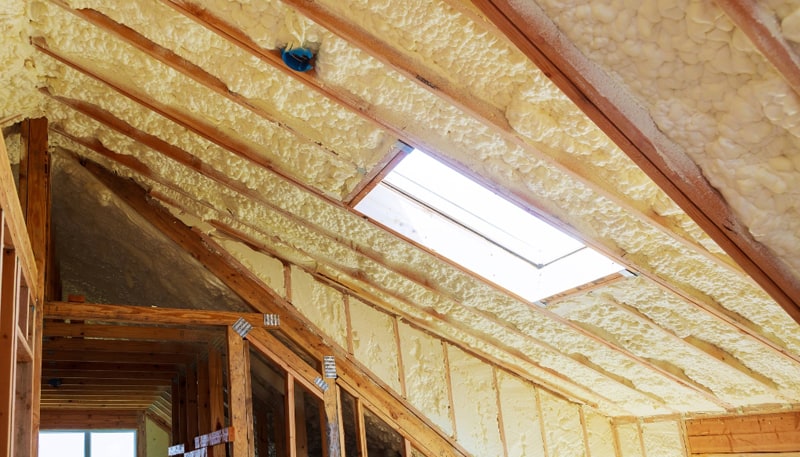Are you looking to maximize energy savings in your home?
Attic insulation is one of the most effective ways to reduce energy bills and maximize energy savings. Properly insulated attics help keep warm air inside during the winter while trapping cool air inside during summer. Imagine how much you can save on heating and cooling costs each year!

In this blog, we’ll discuss the different types of attic insulation available and the best solution for your attic insulation needs.
What is Attic Insulation
Attic insulation is the material that fills the space between your home’s roof and walls. It helps reduce air leakage, maintain a consistent temperature inside the house, and prevent outside air from entering. The process of insulating the attic prevents energy loss, reducing your overall energy usage and saving you money on heating and cooling costs.
Energy Savings With Attic Insulation
Insulation acts as a barrier to the outside air, reducing heat exchange between the attic and the living space. Insulation material also slows down air movement inside the attic, which can help improve indoor comfort levels.
When considering energy savings with attic insulation, it is important to choose an appropriate R-value for your home. The higher the R-value, the better the insulation prevents energy loss. Your attic should be insulated to a minimum of R-30 for maximum efficiency.
To maximize energy savings with attic insulation, it’s essential to determine the best type of insulation and amount needed for your home. This can be done by inspecting the attic to check for any gaps, cracks, or areas of concern. An energy audit is recommended to determine the R-value of existing insulation and identify any air leaks that need to be addressed.
You can hire a professional contractor like iFOAM Columbus Ohio who can evaluate your home’s current insulation levels and recommend the best insulation solution for your energy needs.
Types of Attic Insulation
The most common types of attic insulation are fiberglass, cellulose, and spray foam. Each type has its own set of pros and cons, so it’s important to determine which one is right for your home.
Fiberglass Insulation
Fiberglass insulation is the most commonly used type. It’s easy to install and comes in precut pieces, rolls, and batts that are designed to fit snugly between the framing members of your attic. It helps reduce energy costs by keeping warm air during the winter months and cool air during the summer months.
Pros
- easy to install
- cost-effective
- good thermal resistance
Cons
- It can be challenging to work with
prone to settling over time and becoming less effective
Cellulose Insulation
Cellulose insulation is made from recycled paper products such as newspaper, cardboard, and sawdust. It’s blown into the attic in a loose-fill form, similar to fiberglass insulation. Cellulose is more effective at blocking air leakage than other types of insulation and helps keep your home comfortable all year round.
Pros
- good thermal performance
- cost-effective
Cons
- Not as easy to install as other types of insulation
Spray Foam Insulation
Spray foam insulation is a popular choice for many homeowners due to its ability to fill even the tiniest crevices, providing superior air sealing and energy efficiency. It expands when applied, filling in all the cracks and crevices that can cause energy loss.
Pros
- Superior air sealing
- Excellent thermal resistance
Cons
- Cost more than other types of insulation
The Best Insulation Material for Maximum Energy Savings: Spray Foam Insulation
For maximum energy efficiency, spray foam insulation is the recommended type of insulation. It acts as a barrier to outside air, preventing heat exchange between the attic and living spaces, and slows down air movement inside the attic. This helps improve indoor comfort levels and save money on energy costs.
Plus, spray foam insulation is easy to install and provides superior air sealing and thermal performance compared to other types of insulation. It also helps keep moisture levels low, preventing mold growth and preserving your home’s structural integrity.
With its superior energy efficiency, spray foam insulation is the ideal choice for homeowners looking to maximize energy savings in their attic. When combined with proper ventilation and an effective weatherization plan, it can be a great way to reduce energy costs and keep your home comfortable year-round.
Factors to Consider When Undergoing an Attic Insulation Project
When undergoing an attic insulation project, several important factors must be considered. First and foremost, you want to ensure that the insulation will be installed correctly to achieve maximum efficiency. This means ensuring that all gaps and cracks are sealed up with spray foam or other sealants and properly insulating every pipe or duct.
You should also consider the R-value of your insulation. The higher the R-value, the better insulated your attic will be. If you have an older home with little or no insulation in the attic, investing in higher quality materials such as spray foam or cellulose insulation is a good idea.
Finally, it’s essential to make sure you are installing the correct type of insulation for your climate and home. Different types of insulation perform better in different climates, so it’s important to consult a professional to determine which type is best for your situation.
Conclusion
Whether you choose fiberglass, cellulose, or spray foam insulation, maximizing energy savings with attic insulation is an important step in boosting your home’s value. With the correct type of insulation and a proper installation process, you can save money on monthly utility bills and increase the comfort level of your home. Be sure to consult a professional contractor to determine the best solution for your needs – the benefits are well worth it!
